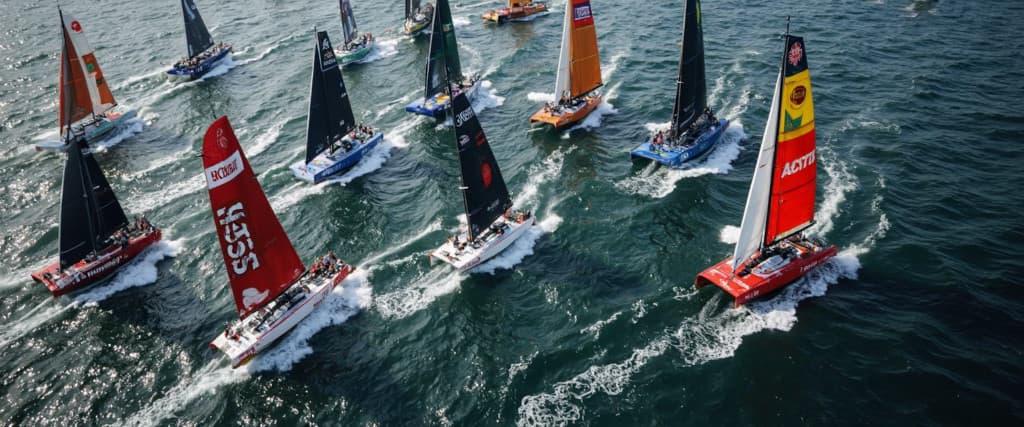Associative Remote Viewing for Yacht Racing
Yacht racing — like any competition at sea — is full of danger and unpredictability. Storms, sudden wind shifts, and mechanical failures can change everything in seconds. For example, in 2019, during the Fastnet Race, over 200 yachts were caught in violent weather that no one could have fully predicted.
Should you stop enjoying it? Probably not. But can you sharpen your ability to anticipate what’s coming? Actually, yes — through a method called Associative Remote Viewing (ARV).
This technique is described in a book by Debra Lynne Katz and Jon Knowles, who combined their deep experience to create a comprehensive guide for anyone interested in learning about psychic powers and how they can be applied to professional sports betting, among other applications.
Looking ahead, I’ll say this: yes, there have already been cases where people — those who call themselves remote viewers — have succeeded in predicting horse racing and crypto trading outcomes.
So, What Is ARV? Definitions Below
To begin, let’s take a look at the key terms.
Associative Remote Viewing (ARV) is a technique aimed at predicting future events by linking the result of a remote viewing session to specific possible outcomes.
Remote Viewing itself involves attempting to perceive or describe details about a distant or unseen target using extrasensory perception (ESP). It’s a skill that requires training and practice. You need to practice about three to four times a week. The first sessions should focus on recognizing your first impressions and last around 15–20 minutes. Gradually, as you add more exercises, increase the duration to 40–50 minutes, or at most one to two hours. It’s important to note that you don’t become a remote viewer in a day or even a week — that’s what makes it challenging.
However, we’ve found a great app called Verevio, and we’d like to share it with you. It offers various training tools suitable for beginners that help you recognize and refine your initial impressions. You can also practice remote viewing there. With time, you may try ARV yourself.

Now let’s take a closer look at the ARV method and how it can work in yacht races.
Example of ARV Session for Yacht Racing
Here’s a simple scenario: Tomorrow, three yachts will compete: Blue Wave, Storm Rider, and Sea Spirit.
The organizer (you’ll need a partner for this) creates a hidden list, assigning each yacht a specific image:
- Blue Wave = picture of Land
- Storm Rider = picture of Sea
- Sea Spirit = picture of Lifeform
Before the race, the viewer (either you or a partner trained in remote viewing) is asked to describe the image they will see after the race is finished.
The viewer sketches the image and writes down all impressions that come to mind.
Once the race is over, the organizer compares the viewer’s sketch and impressions with the hidden list to determine which yacht is likely to win.
Finally, you compare the prediction with the actual race results to see how accurate the session was.
Why People Try This in Sailing
This approach doesn’t rely on logic but on extrasensory perception. For beginners, ARV often serves as an experiment — a means to test and develop their intuition.
It often happens that we rely on logic and ignore our inner voice, but it turns out that it can be far more accurate than all the rational observations based on logic. For instance, a study by Professor Marius Usher at Tel Aviv University found that participants made correct decisions up to 90% of the time when relying solely on their intuition, even without conscious reasoning. Those who have learned to skillfully interpret their sixth sense can get an intuitive advantage.
Does It Work?
Experiments with ARV show mixed results. Sometimes predictions are surprisingly accurate, but success depends on many factors:
- the skill of the remote viewer,
- the clarity of the associations,
- and how well the descriptions are judged.
It is worth noting that without experience and practice, people can mistakenly read information during sessions — this is the catch: developing intuition requires a lot of training. But those who do remote viewing regularly report exceptional results.
In short, ARV is not a guaranteed method — it’s more like an extra advantage.
Final Thoughts
Associative Remote Viewing should not be seen as a replacement for weather models or race analytics. Tests have shown that the more qualified the viewers, the better the results. By “qualified”, we mean not only having advanced remote viewing skills but also possessing relevant professional expertise — such as years of experience in yacht sports, regular participation or observation of races, familiarity with competitors, and other domain-specific knowledge.
